Hearst Newspapers’ American Weekly, December 29, 1946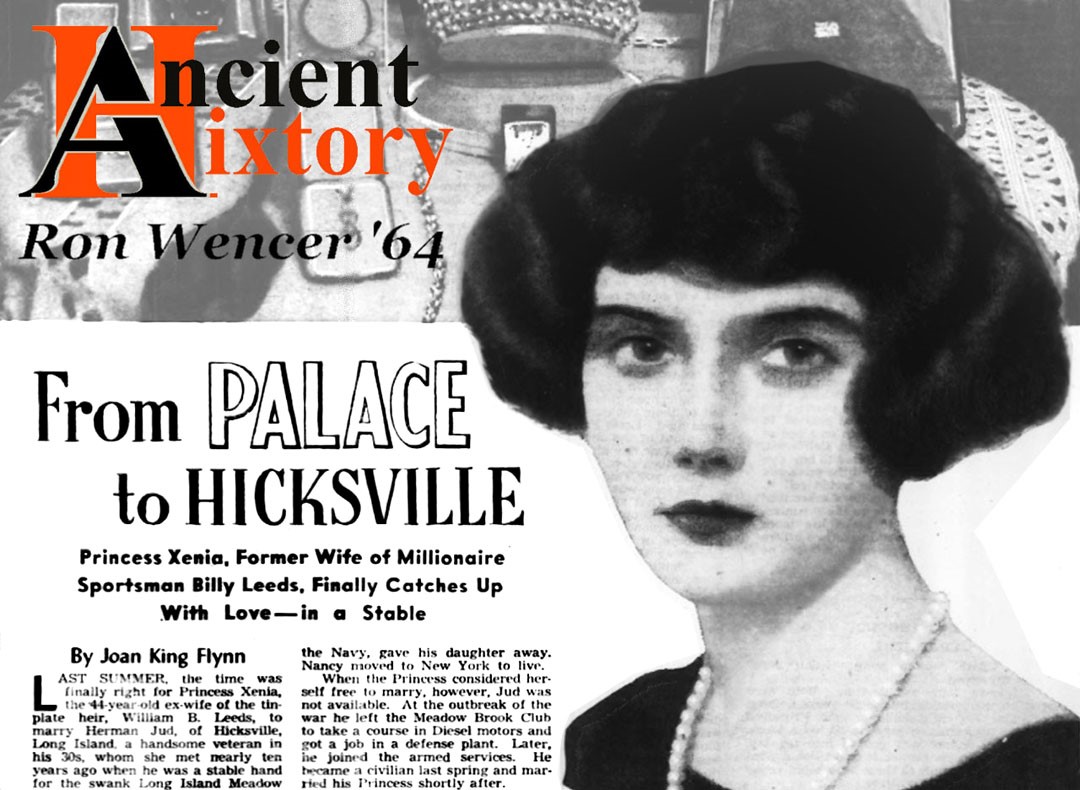
Introduction
This is history, not a fairy tale. There are no glass slippers or poisoned apples – but there is a tragic princess who forgoes much of her wealth, and who eventually settles down in a quiet, happy marriage with a one-time stable hand from Hicksville.
To understand how this came to pass, one needs to know some things about Long Island’s Gold Coast in the 1920s, and about these people:
- William Leeds Jr., wealthy young mid-westerner who moved to the Gold Coast
- Princess Xenia of Greece, born Princess Ksenia Georgievna Romanov of Russia
- Herman Jud, one-time Gold Coast stable hand
The Gold Coast
From Queens to western Suffolk, the woodlands of the North Shore were once the backdrop for the gossamer lives of the extremely wealthy. Their yachts dotted the coves, much as their estates dotted the hills. Their stables housed fine, fast, and beautiful horses, upon whose backs their children learned how to jump over fences and hedgerows. Skills like that would be essential years later, when the grown children participated in crazily zigzagging fox hunts, that could stretch over the countryside from the North Shore as far south as Uniondale.
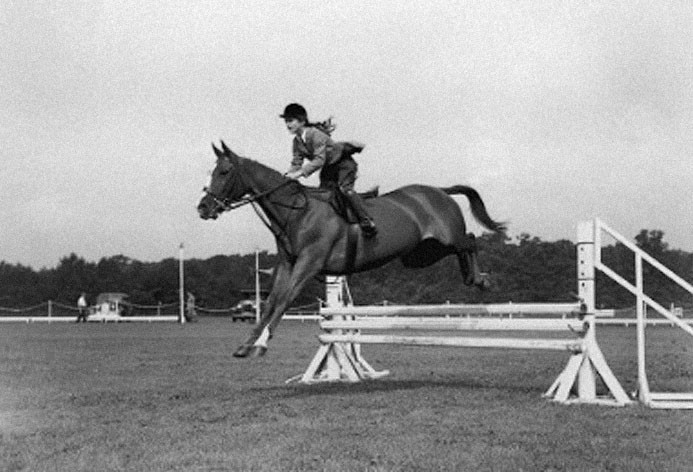
Locust Valley, 1939: 10 year old Jacqueline Bouvier (later Kennedy)
Bert Morgan photograph at HarpersBazaar.com
As the 1920s roared, some “old money” Gold Coast families were displaced by the nouveau riche. Tabloid newspapers entranced readers with accounts of these newcomers’ lives. They spent money as readily as they breathed. They liked speedboats more than yachts, and they liked airplanes even more, using them as casually as ordinary people use taxis. They might fly to Atlantic City for an afternoon, or to Chicago merely to be seen at some glitzy soirée.
Meanwhile, in nearby mainstream villages like Hicksville, the residents lived normal lives, perhaps wondering now and then what life on the Gold Coast was really like.
William Leeds, Jr.
In the 19th century, most durable housewares used in Europe and America were fabricated from special tin-plated steel, a material commonly called tinplate. Indiana’s William Leeds Sr. had acquired a profitable near-monopoly on tinplate. When he died in 1908, Leeds left assets totaling $40 million (in terms of 2023 dollars, that’s more than $1.2 billion), most of them in a trust fund he established for his son Billy.
As a minor, Billy and his widowed mother lived comfortably on the trust fund’s interest. As a young adult, he had access to the principal, and he began careening through life like a rudderless speedboat, following impulses from one caper to another, and risking life and limb – not always his own.
The Russian Princess
In the summer of 1903, Ksenia Georgievna was born in a ducal palace in St. Petersburg, within walking distance of the Tsar’s Winter Palace. She was the daughter of a Russian Grand Duke who held a high position in the government of his cousin, Tsar Nicholas II. Ksenia’s mother was Princess Maria of Greece and Denmark. Maria’s father was King George I of Greece. Her mother was a granddaughter of Russia’s Tsar Nicholas I.
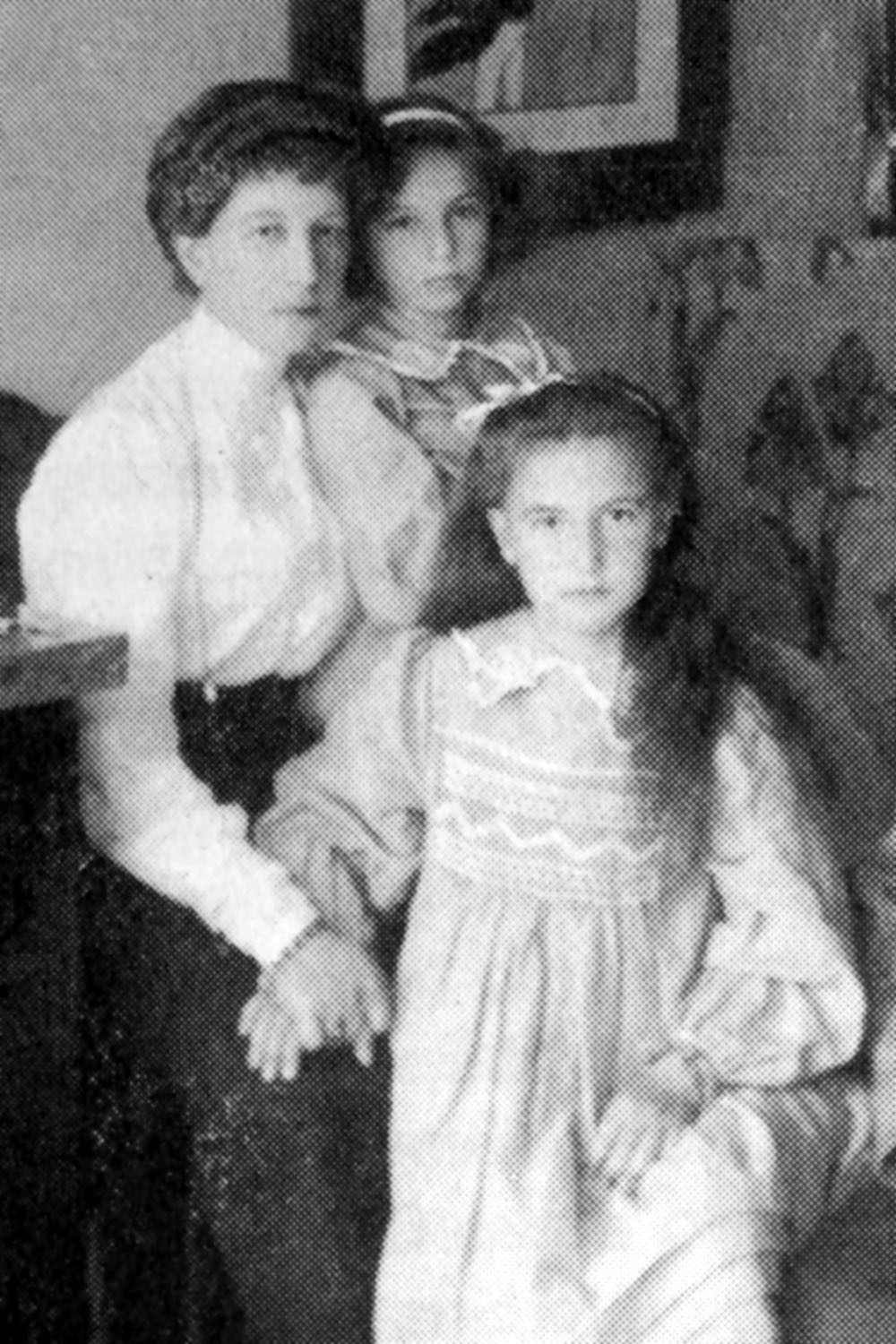
Princess Maria with daughters Ksenia and Nina
Wikimedia Commons
In 1914, as in most years, the Grand Duke’s work responsibilities forced him to visit a number of distant Russian locales. While he was away, Maria took their daughters to Great Britain, to meet some distant cousins who also were members of the extended British royal family. World War I erupted, soon making a return to Russia impossible. Within a year, the Grand Duke was imprisoned by revolutionaries. He repeatedly wrote to his wife, imploring her to lobby the British government to secure his release – which it could not do.
In 1918, the Tsar and his household were slain by their Bolshevik captors. In 1919, the Grand Duke met the same fate in St. Petersburg’s Peter and Paul Fortress (which traditionally had been used by the Romanovs to imprison their political enemies). It still stands, directly across the Neva River from the Grand Duke’s palace.

Peter and Paul Fortress, viewed from across the Neva
photograph by Ronald A. Wencer
Everything had changed. The daughters were devastated by the news of their father’s death. Their once-wealthy family now was impoverished, because all Romanov assets had been seized by the new government. With the Russian monarchy now irrelevant, the press took to calling Ksenia by her Greek title: Princess Xenia of Greece.
Herman Jud
In comparison, Jud’s background was humble. His Austrian-born father Charles had settled in Hicksville, where at first he made barrels at the Heinz pickle works. When Heinz closed due to blight-induced crop failures, Charles instead worked repairing railroad cars (not a huge leap for a cooper; as in those years, freight cars were constructed of heavy wooden timbers and wood sheathing). The family of Herman’s mother Katie Fricke Jud had been in Hicksville since the 1880s; they made and sold confections.
Herman was born in 1911. His brothers Charles and August (Augie) went on to serve in Hicksville’s Fire Department for many years, advancing to a number of senior positions. It’s harder to discover much personal information about Herman, however, and it’s almost impossible to find a photograph of him. The only one I have located appears in this news item from the Nassau Daily Review-Star of January 31, 1944:
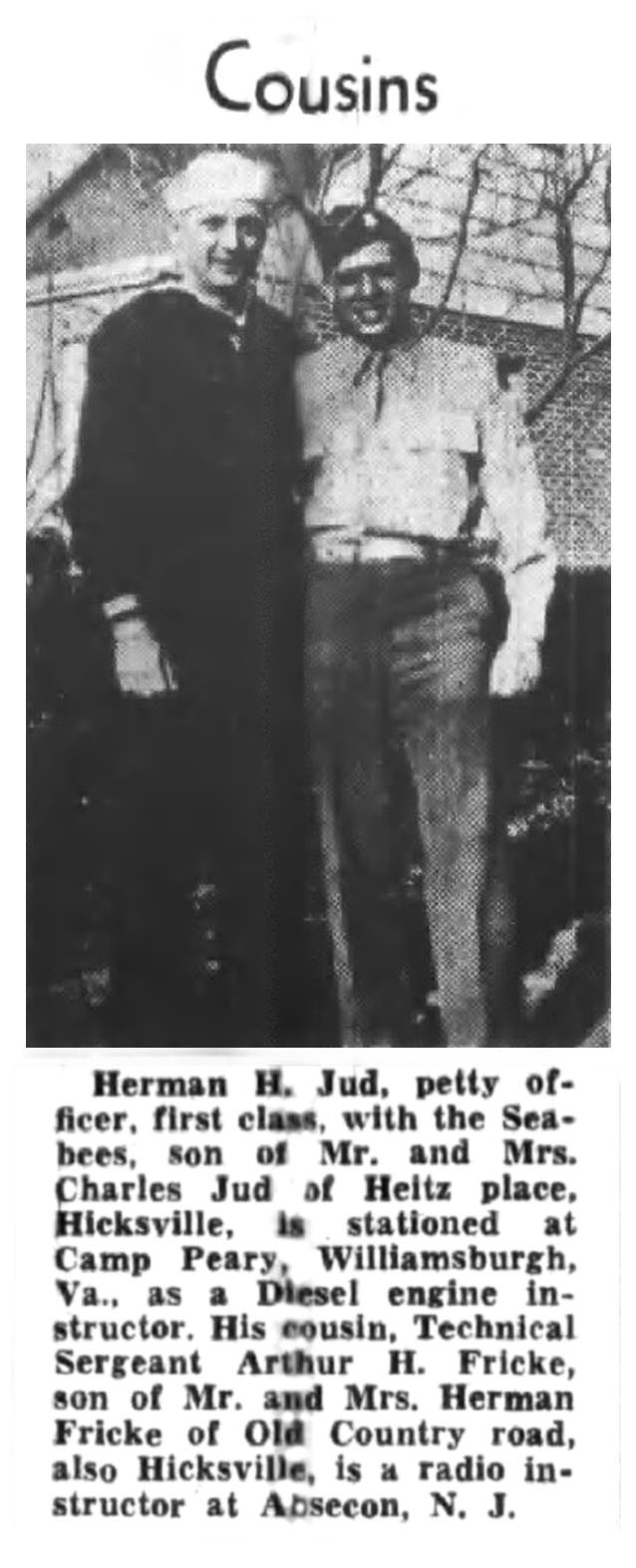
Herman attended Hicksville High School, but a U.S. Census indicates that – like many other students in those years -- he left after completing his second year (likely in the Spring of 1927). In 1930 the Long-Islander newspaper’s Hicksville page noted that Herman owned a Buick Marquette, a model that had just been introduced that year:

Per the 1930 Census, Herman worked as a “strapper” – the entry-level stable job, which involves everything from mucking out the stables to cooling down horses after exercise. The 1940 Census indicates that he then was a groom on a private estate; his reported income was somewhat above average. Did he choose such employment in part because he wanted to experience life on the fabled Gold Coast?
Mrs. Xenia Leeds
Billy and Xenia Forever ♥
Billy’s widowed mother Nonie (née Nancy) wanted a royal title that would lend gravitas to her presence in European society, to which her fortune had already given her entry. She looked to Greece – a very poor country, whose royal family constantly needed influxes of foreign cash. Nonie got her title – Princess Anastasia of Greece – in 1921, when she married a brother of the King, and coincidentally became the sister-in-law of Xenia’s mother, Princess Maria.
When Xenia visited her new aunt, she met Nonie’s son Billy Leeds. He was Xenia’s age, quasi-royal, full of energy, and he exuded money the way that a blacksmith at a hot forge exudes sweat. Billy and Xenia thought they were in love. They soon wed, and five years later they had a daughter, named Nancy in honor of Princess Anastasia.
A Most Exciting Couple
In a way – as it turns out, not a good way – Billy and Xenia were complementary. She lacked money, but she respected people, had a warm heart, and she was loyal to family and friends. He had money, but he tried desperately to gain people’s respect – or at least their attention – by being a daredevil. In news stories, he seemed more cartoon than man, perhaps a slave to his impulses:
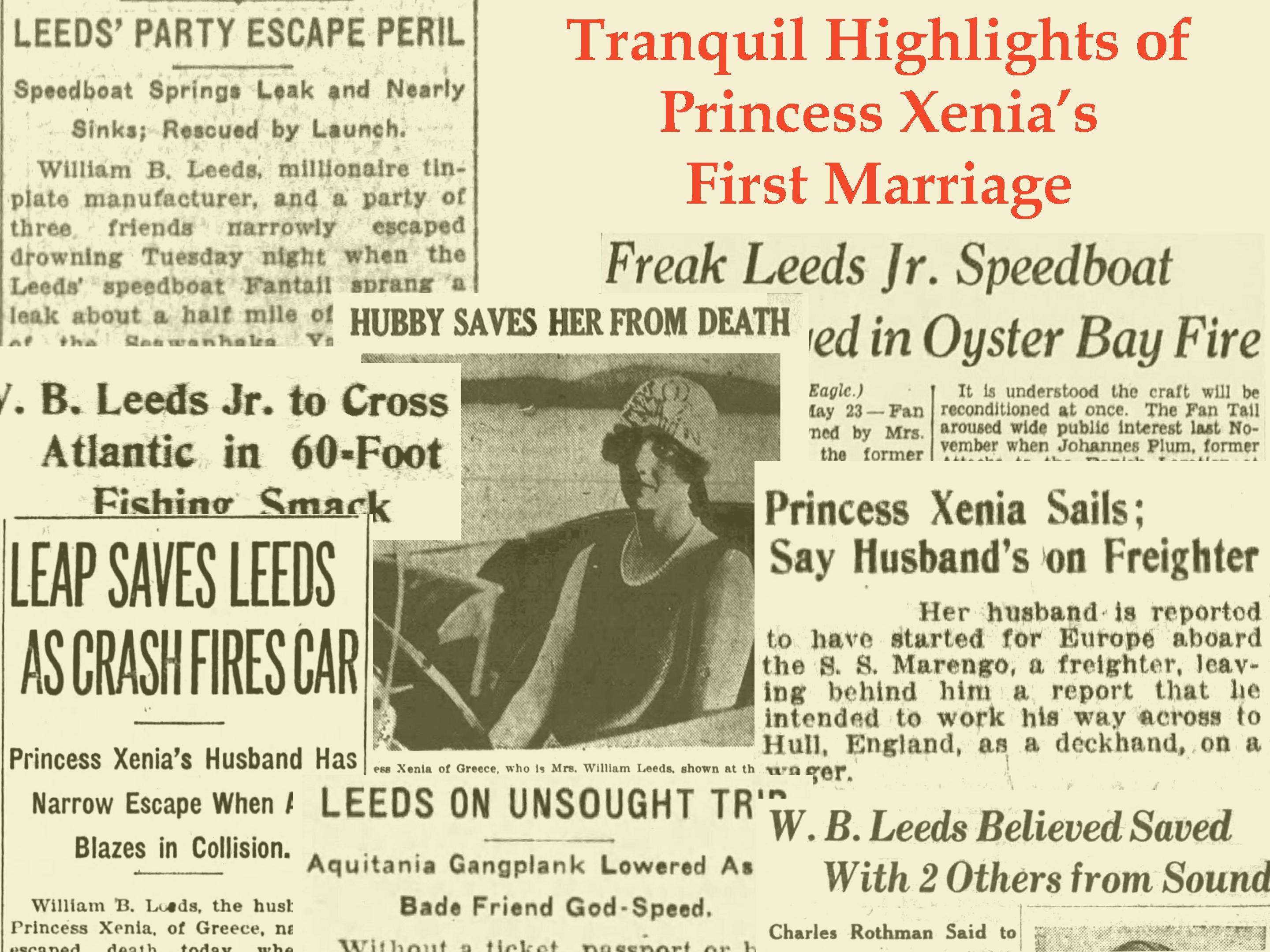
Brooklyn Daily Eagle, Brooklyn Times-Union, Brooklyn Citizen
Xenia, having spent her childhood missing her always-traveling father, and her adolescence mourning his imprisonment and murder, craved domestic stability and security. Instead she got cheap headlines.
One incident is especially ghastly. In 1928, rising stars Fred and Adele Astaire had just completed the smash New York run of a new Gershwin musical. Before heading to London for its premiere there, they spent a weekend at the Leeds’ home in Cold Spring Harbor. The main feature of the home was a second floor ballroom, which projected out over the water. Billy’s record-breaking but finicky speedboat would dock beneath the ballroom.
The Leeds and the Astaires decided to take the speedboat out for a run. Xenia and Fred stood waiting as Adele and Billy boarded the boat. When Leeds started the engine, flaming gasoline exploded across the boat’s deck. Billy, only too accustomed to such surprises, got Adele off the boat and into the arms of the others. He jumped out of the boat, unmoored it, and shoved it into the harbor, where it burned to the water line.
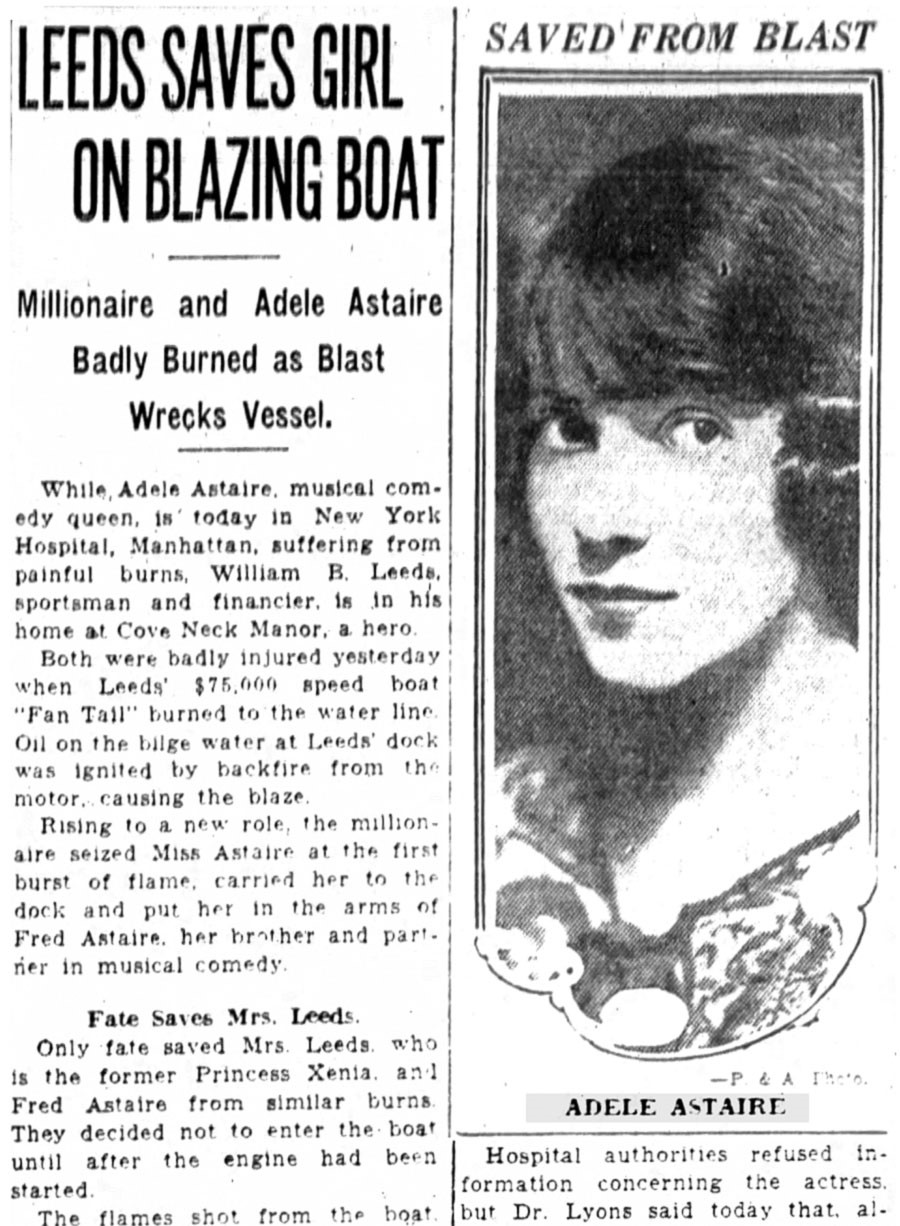
Brooklyn Times-Union, July 9, 1928
The burns to Adele’s torso were neither life-threatening nor publicly visible, but they were painful, and following plastic surgery, they needed time to heal. The press said nothing about lawsuits, but one imagines that Leeds offered financial compensation for the trauma and injuries, and also for the consequent delay of the London premiere.
One also can imagine that Xenia realized that things might easily have been much worse, perhaps even picturing little Nancy as an orphan.
A Single Mother on the Gold Coast
Was it simply a matter of “Enough Already”?
In 1926, rumors of a Leeds divorce began to appear in the press. They may have been mere speculation, but they proved prophetic. Xenia was granted a divorce in 1930.
Why had she wanted the divorce? On that score, no one was talking. Court records probably would not provide an answer. At that time, New York State granted divorce only on the basis of infidelity – which meant that people who filed for divorce always claimed that their spouses had been unfaithful, whether or not that was true. Remember the Rogers-Astaire film The Gay Divorcee?
Perhaps Billy’s obvious inability to be a rock-steady family man was at fault, but there seem to be no objective memoirs, diaries, or biographies to verify that. Before Xenia’s mother Maria died in 1940, she wrote memoirs, but her daughters never had them published. Her grandchildren did, but not until 1988, more than a half century too late. By then, all the people who knew the truth were gone. The grandchildren who edited the memoirs had come by their family knowledge second-hand. Such knowledge is usually incomplete, misremembered, distorted, biased, and/or sanitized.
Still in High Society
It is obvious that Xenia – who years later would choose to retreat from Gold Coast society – felt a maternal obligation to educate young Nancy in the equine ways of the wealthy. Many a childhood weekend was spent at a horse show, steeplechase race, or jumping competition. At these events, socialites walked the grounds, venturing into stables to see other owners’ horses, interacting with each other, and also with the grooms and stable hands. Young Nancy would have been full of questions for the latter.
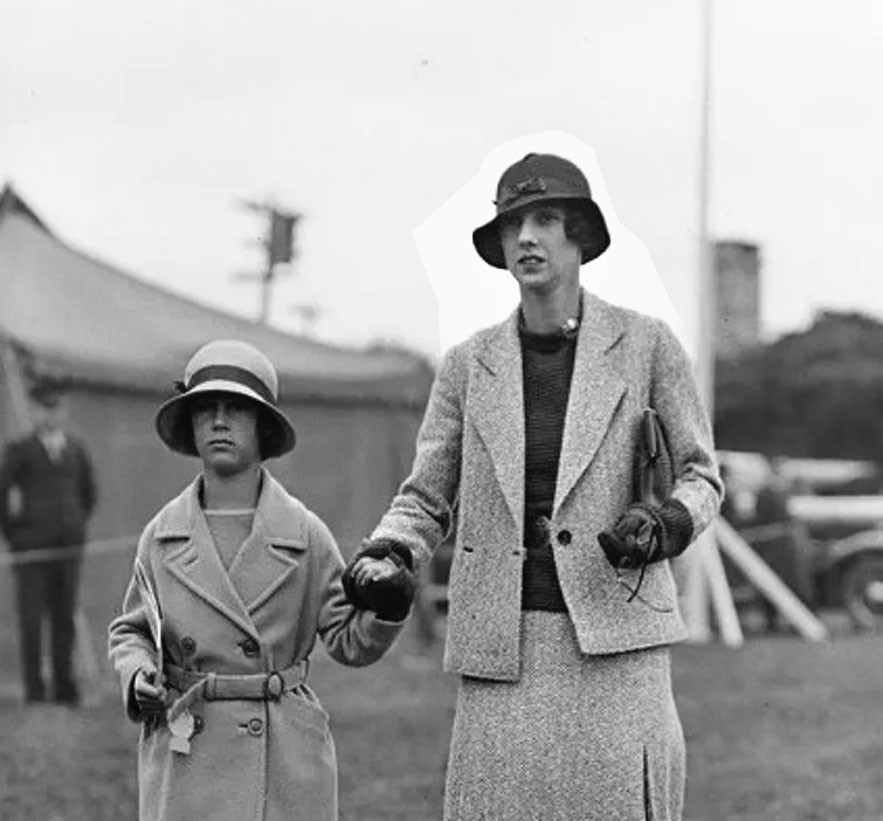
Nancy and Xenia at a horse show, 1934
findagrave.com
Princess and Groom
When Did They Meet?
From perhaps 1927 on, Herman Jud would have been working at Gold Coast events, eyeing the horses, visiting other stables, and chatting with anyone who stopped by to look over the horses he tended. When news of the couple’s wedding broke in 1946, after nearly two decades of their each attending equestrian events without anyone’s linking them romantically, the news reports all outlined the same basic story:
- The couple first met c.1937, when Herman worked at the Meadow Brook Club
- They were attracted to each other, but
- They decided to do nothing about it until Nancy was older
- The uncertainty of World War II caused further delays
- When Herman returned from the war, they at last were free
Well... maybe. One can quibble – there could not have been a lot of concern that Herman would not come back from the war, as he did not enlist until October 1943, and then was posted stateside as an instructor. Of course, there may have been other considerations, involving Nancy’s fiancé or her father, both of whom had wartime military duties.
Regardless, the assertion that Xenia and Herman first met in 1937 rankles me. Early in the 1930s, Xenia’s mare Jada was a steeplechase champion who attracted lots of attention for herself and for her owner. Xenia also rode in fox hunts in those years, including one with more than one hundred riders, hosted by the Meadow Brook Club, where Herman later was said to have worked. One expects that they would have met long before 1937.
Mystery Man?
In this vein, my suspicious mind leads me to include the following photograph. It was taken at the 1930 running of the annual West Hills Plate, a prestigious, notoriously difficult, and outright dangerous steeplechase event that traversed adjacent private estates in the Town of Huntington.
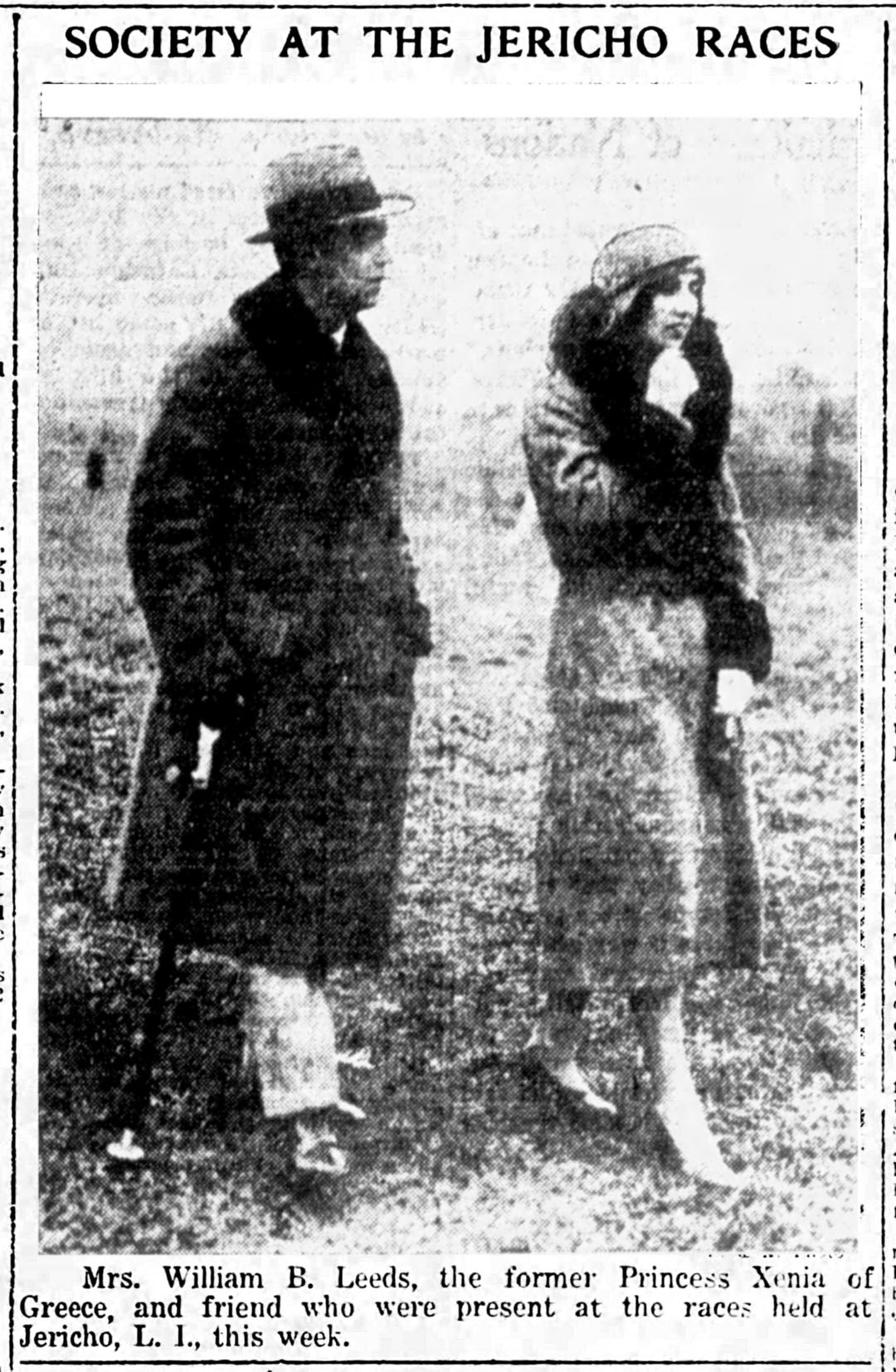
Brooklyn Daily Times, November 7, 1930
There are many photographs of Xenia walking around at horse-y events, but I have not found another in which she is walking with a man. The caption’s wording -- “Princess Xenia of Greece and friend” – deliberately suggests he and the newly divorced princess are more than acquaintances.
I find this man’s stature reminiscent of the Herman Jud in the “Cousins” newspaper photo we saw earlier. Could he be Herman? His garb is pretentious for a youth of 19 who works in a stable, but Herman may have been trying to impress people. Moreover, one might infer from Herman’s Buick that he was capable of saving his earnings when he wanted to buy expensive things.
Regardless, I’m not implying that Xenia (or Herman) was involved in anything shameful in 1930. I just find it hard to understand how it took about a decade of attending the same events, weekend after weekend, for Xenia and Jud to finally notice each other.
Til Death Do Them Part
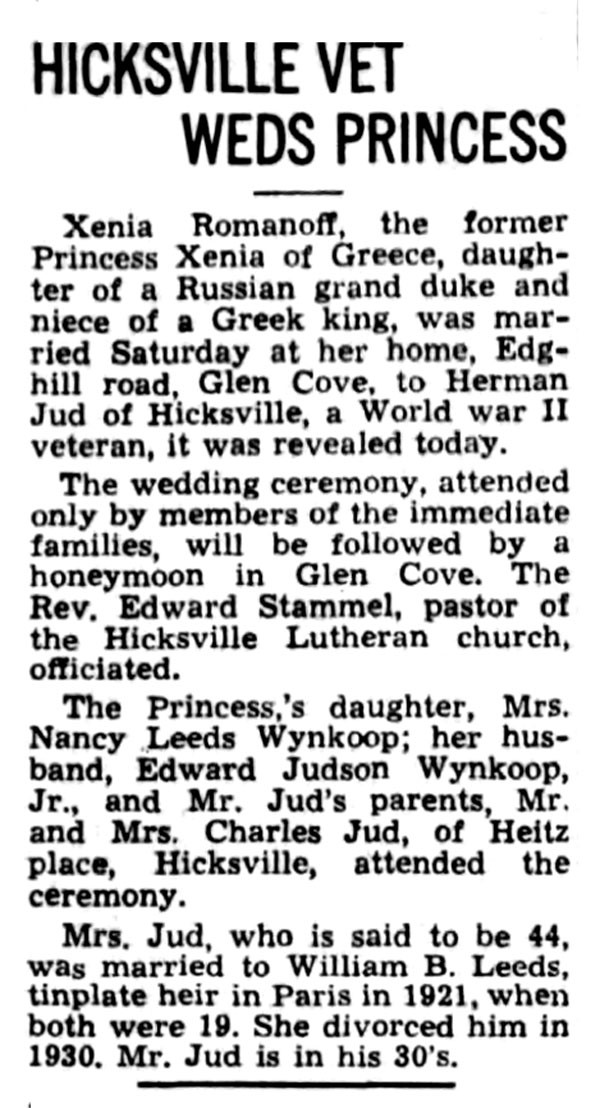
Nassau Daily Review-Star, August 13, 1946
The article above is typical of how the news media reported the wedding. There were slight differences from one report to another (e.g., the New York Times mistakenly reported that Henry was an Army veteran), variations which suggest that the different wire services and papers conducted hurried interviews with whomever answered the telephone at the church office.
At the end of 1946, a single-page American Weekly story (some of which is shown at the start of this article) was published nationwide. It reported that after four months of marriage, Xenia and Herman were enjoying their low-profile life in Glen Cove. The home in which they lived, set far back from the road, still stands today.
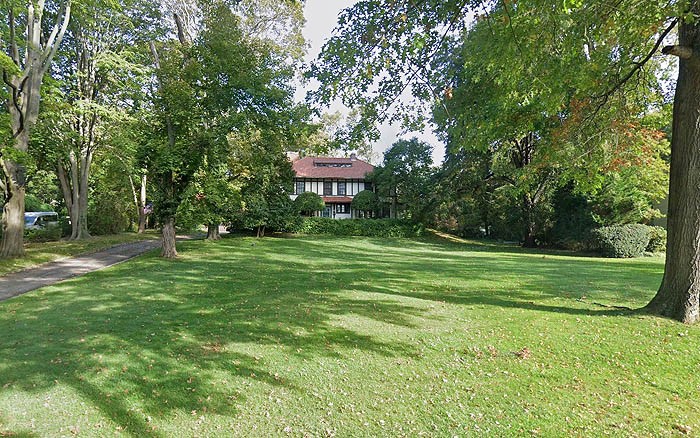
Google Streetsview
Conclusion
Xenia died in 1965 and was buried at St. Paul’s Churchyard in Glen Cove.
According to her obituary, Herman then worked as “an engineer dealing in air compressor installations.” He later moved to Virginia, where he had served during WW II. He remarried, but he divorced several years later.
Eventually, he married once more, this time to a widow from New York named Fricke (it seems likely that her late husband had been one of Herman’s cousins). They remained married until Herman died in 1987. He was buried in Calverton.
findagrave.com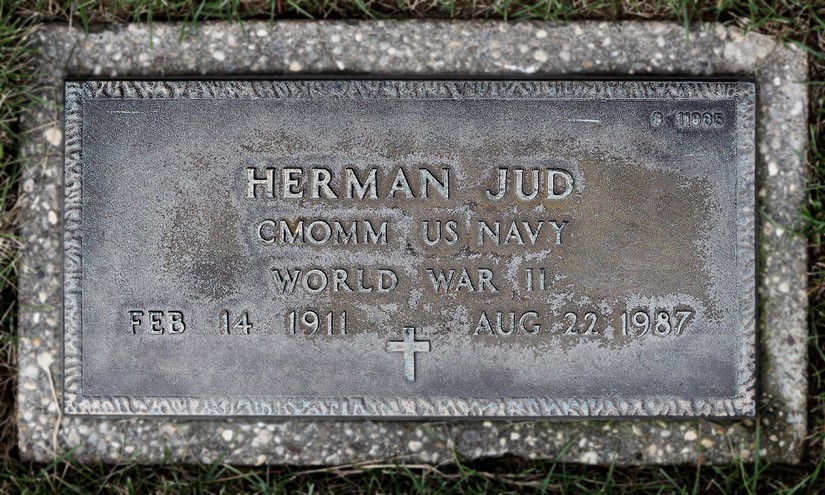
It’s ironic that a young Hicksville man who was drawn to the excitement of the Gold Coast won the heart of a princess – and that she fled with him from that excitement as soon as she could do so in good conscience.
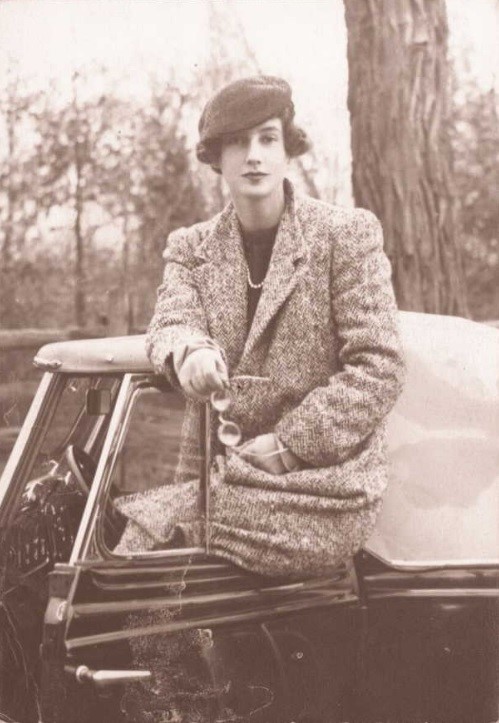
Tumblr.com
RIP Xenia Romanov, and RIP her beloved Herman Jud.

